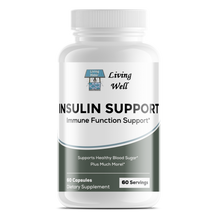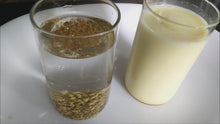ROC803 Blood Sugar Insulin Support from Living Well
This proprietary blend from Living Well for blood sugar and insulin support is the best natural blend available. The ingredients and supplements provided are support for the root problems for high bllod sugar and the need for insulin.
This is a potent blend for insulin support...
Vitamin C, Vitamin E, Biotin, Magnesium, Zinc, Manganese, Chromium, Banaba Leaf, Guggul, Bitter Melon, Licorice Root, Cinnamon Bark, Gymnema, Sylvestre Leaf Powder, Yarrow Flowers Powde,r Cayenne Pepper Powder, Juniper Berry Powder, White Mulberry Leaf Powder, Vanadium, Alpha Lipoic Acid, and L-Taurine
Additional Medicinal Plants
and Herbs for Diabetes
Throughout history, many cultures have relied heavily on plants and herbs for medicinal purposes. Modern medicine is now looking at how these traditional sources can be used to treat and manage diabetes either along with conventional medications or on their own. The source and purity of an herb is crucial for effectiveness and to minimize any possible side effects. Professional guidance is always advised when using herbal remedies. Research has been conducted on many sources of medicinal herbs including the following:
American ginseng (Panax quinquefolium) – American ginseng appears to lower blood glucose levels by enhancing insulin secretion (1). One study found that people with type 2 diabetes who took American ginseng before or with their meal experienced a moderate reduction in glucose levels after the meal (2).
Bay (Laurus nobilis) – Bay leaf is demonstrated to help the body use insulin more efficiently at levels as low as 500 mg which is less than half a teaspoon. Other spices like cinnamon, cloves, turmeric, coriander, and cumin are also good at controlling blood sugar levels (3).
Berberine – Research has shown that 500mg of Berberine taken 2-3 times daily was able to control blood sugar and lipid metabolism as effectively as metformin (4).
Bitter Gourd (Momordica charantia) – This particular plant, also known as bitter melon, has attracted considerable interest for its ability to regulate blood sugar (5).
Cayenne (Capsicum frutescens) – This is another herb used in alleviating pain associated with diabetic neuropathy. It is commonly called chili pepper and is used in the form of an external cream.
Cinnamon – This popular spice has demonstrated an ability to increase insulin sensitivity and reduce both blood glucose and cholesterol levels in people with Type 2 diabetes (6,7). Diabetes Action funded research by Dr. Richard Anderson’s lab discovered that a new water-soluble polyphenol type-A polymer was the most effective and safe ingredient (8). Because whole cinnamon includes fat soluble components such as coumarin, which may be toxic at high doses, only the water soluble extract with patented names such as Cinnulin PF or CinnSulin should be used. Additional studies funded by Diabetes Action found this same cinnamon extract has shown neuroprotective effects on the brain which can lead to improved prevention and treatment of Alzheimer’s disease (9). Many researchers are now calling Alzheimer’s Type 3 Diabetes.
Curcumin (Turmeric) – A commonly used food spice that has been traditionally used for pain and wound healing but also appears to inhibit autoimmune disease by regulating inflammatory cytokines. Research has shown that curcumin may be 400 times more powerful than the common diabetes drug Metformin in improving insulin sensitivity and helping to reverse type 2 diabetes (10).
Evening Primrose Oil (Gamma linolenic acid or GLA) – Defective fatty acid metabolism in diabetes may lead to impaired nerve function and can contribute to the development of peripheral neuropathy. Initial studies suggest that evening primrose oil, which is rich in gamma linolenic acid, improves blood flow and nerve function (11).
Fenugreek (Trigonella foenum-graecum) – Fenugreek, a common ingredient in Indian and Middle Eastern cuisine, has been shown to help regulate blood sugar levels and increase good (HDL) cholesterol while lowering total cholesterol (12). In addition, fenugreek seeds are a good source of soluble fiber.
Flax (Linum usitatiisimum) – Flax seed is one of nature’s richest sources of soluble fiber. Research has shown a significant improvement in glucose values by the intake of flax fiber (13). In addition, flax oil is an excellent source of alpha linolenic acid (omega-3 fatty acid). Either ground flax seed or its oil can be used in bread or muffins.
Ginger (Zingiber officinale) – Most commonly used as a flavoring for food, ginger may also be taken orally in higher amounts for various kinds of digestive relief. Limited studies in animals with diabetes show that ginger may reduce blood levels of sugar and cholesterol (14,15,16).
Ginko Biloba – For patients with type 2 diabetes who were poorly managed on metformin, the addition of a Ginkgo Biloba extract was effective in improving treatment outcomes. (17)
Gurmar (Gymnema sylvestre) – In a 2000 study conducted by Diabetes Educators, 65 patients showed a significant reduction in A1C levels when they took a commercial supplement that contained 400 mg of gymnema sylvestre leaf extract (18).
Hydroxycitric Acid (HCA) – This herbal compound found naturally in the grindle berry, Garcinia Cambogia, may play an essential role in lowering cholesterol and for weight reduction by suppressing appetite. Mixed results and potential side effects show the need for further research. HCA should not be used by anyone taking either cholesterol or diabetes medications (19).
Lagerstoemia speciosa – This plant is commonly called Banaba in the Philippines, also known as Crepe Myrtle, Queen’s Flower or Pride of India. It has been shown to regulate blood glucose levels by increasing insulin action (20).
Nopal (Opuntia fulignosa) – Nopal, also called the prickly pear cactus, is a popular food in Latin America. Numerous studies regarding its role in controlling and lowering blood sugar have been conducted. An Austrian study showed that opuntia decreased blood lipids, blood glucose, and increased insulin sensitivity in people without diabetes (21).
Onions and Garlic (Allium cepa and Allium sativum) – The use of onions and garlic to reduce blood sugar levels has been popular in Asia, Europe and the Middle East. These plants contain the sulfur compounds allicin and allyl propyl di sulphide which have chemical structures similar to insulin, and therefore are believed to reduce blood sugar.
Pomegranate (Punica granatum) – This delicious fruit contains many beneficial substances such as polyphenols, that have antioxidant, anti-viral, and anti-tumor properties. Its cinical role is being explored now with encouraging initial results in lowering lipid levels in people with diabetes (21) and improving blood flow to the heart (23).
Pycogenol – This extract of pine bark has been used in some countries to treat diabetic retinopathy and diabetic ulcers. A German study showed a positive effect on lowering glucose levels (24).
Red Yeast Rice (monascus purpureus) – Although many doctors prescribe statin drugs to lower LDL cholesterol levels, research has shown similar anti inflammatory and lipid lowering effects from taking red yeast rice. However, this should only be taken under medical supervision as the red yeast rice extract does contain the same chemicals as the prescription drug lovastatin (25).
Resveratrol – This polyphenolic compound is found in various plants such as grapes and berries. There has been compelling evidence on the strong anti-inflammatory potential of Resveratrol as an anti-aging agent (26).
Silymarin (Milk Thistle) – This herb has been used to treat liver diseases for many years. Recent research has shown that silymarin reduces insulin resistance and significantly decreases fasting insulin levels and lowering liver enzyme levels better than patients taking metformin (27).
Sulforaphane – This phytochemical is found in cruciferous vegetables such as broccoli, kale, and cabbage. It has not only shown strong cancer preventive actions, but has been able to show a reduction of blood sugars by 10% (28).
Tea (camellia senensis) – Due to its high antioxidant polyphenol content, in traditional Chinese and Indian medicine, green tea has been used successfully in promoting digestion, wound healing, lowering blood glucose, and improving heart health. Research shows that black, green, and oolong teas increase insulin sensitivity (29). However, herbal teas were not effective because they do not contain camellia senensis.





